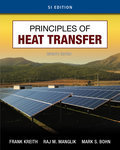
PRINCIPLES OF HEAT TRANSFER was first published in 1959, and since then it has grown to be considered a classic within the field, setting the standards forcoverage and organization within all other Heat Transfer texts. The book is designed for a one-semester course in heat transfer at the junior or senior level, however, flexibility in pedagogy has been provided. Following several recommendations of the ASME Committee on Heat Transfer Education, Kreith, Manglik,and Bohn present relevant and stimulating content in this fresh and comprehensive approach to heat transfer, acknowledging that in today's world classical mathematical solutions to heat transfer problems are often less influential than computational analysis. This acknowledgement is met with the emphasize thatstudents must still learn to appreciate both the physics and the elegance of simple mathematics in addressing complex phenomena, aiming at presenting the principles of heat transfer both within the framework of classical mathematics and empirical correlations. INDICE: 1. BASIC MODES OF HEAT TRANSFER. The Relation of Heat Transfer to Thermodynamics. Dimensions and Units. Heat Conduction. Convection. Radiation. Combined Heat Transfer Systems. Thermal Insulation. Heat Transfer and the Law of Energy Conservation. References. Problems. Design Problems. 2. HEAT CONDUCTION. Introduction. The Conduction Equation. Steady Heat Conduction in Simple Geometries. Extended Surfaces. Multidimensional Steady Conduction. Transient Heat Conduction. Charts for Transient Heat Conduction. Closing Remarks. References. Problems. Design Problems. 3. NUMERICAL ANALYSIS OF HEAT CONDUCTION. Introduction. One-Dimensional Steady Conduction. One-Dimensional Unsteady Conduction. Two-Dimensional Unsteady and Steady Conduction. Cylindrical Coordinates. Irregular Boundaries. Closing Remarks. References. Problems. Design Problems. 4.ANALYSIS OF CONVECTION HEAT TRANSFER. Introduction. Convection Heat Transfer.Boundary Layer Fundamentals. Conservation Equations of Mass, Momentum, and Energy for Laminar Flow over a Flat Plate. Dimensionless Boundary Layer Equations and Similarity Parameters. Evaluation of Convection Heat Transfer Coefficients. Dimensional Analysis. Analytic Solution for Laminar Boundary Layer Flow Over a Flat Plate. Approximate Integral Boundary Layer Analysis. Analogy BetweenMomentum and Heat Transfer in Turbulent Flow over a Flat Surface. Reynolds Analogy for Turbulent Flow over Plane Surfaces. Mixed Boundary Layer. Special Boundary Conditions and High-Speed Flow. Closing Remarks. References. Problems. Design Problems. 5. NATURAL CONVECTION Introduction. Similarity Parameters forNatural Convection. Empirical Correlation for Various Shapes. Rotating Cylinders, Disks, and Spheres. Combined Forced and Natural Convection. Finned Surfaces. Closing Remarks. References. Problems. Design Problems. 6. FORCED CONVECTION INSIDE TUBES AND DUCTS. Introduction. Analysis of Laminar Forced ConvectionIn a Long Tube. Correlations for Laminar Forced Convection. Analogy Between Heat and Momentum Transfer in Turbulent Flow. Empirical Correlations for Turbulent Forced Convection. Heat Transfer Enhancement and Electronic-Device Cooling. Closing Remarks. References. Problems. Design Problems. 7. FORCED CONVECTIONOVER EXTERIOR SURFACES. Flow over Bluff Bodies. Cylinders, Spheres, and OtherBluff Shapes. Packed Beds. Tube Bundles in Cross-Flow. Finned Tube Bundles inCross-Flow. Free Jets. Closing Remarks. References. Problems. Design Problems. 8. HEAT EXCHANGERS. Introduction. Basic Types of Heat Exchangers. Overall Heat Transfer Coefficient. Log Mean Temperature Difference. Heat Exchanger Effectiveness. Heat Transfer Enhancement. Microscale Heat Exchangers. Closing Remarks. References. Problems. Design Problems. 9. HEAT TRANSFER BY RADIATION. Thermal Radiation. Blackbody Radiation. Radiation Properties. The Radiation Shape Factor. Enclosures with Black Surfaces. Enclosures with Gray Surfaces. Matrix Inversion. Radiation Properties of Gases and Vapors. Radiation Combined with Convection and Conduction. Closing Remarks. References. Problems. Design Problems. 10. HEAT TRANSFER WITH PHASE CHANGE Introduction to Boiling. Pool Boiling.Boiling in Forced Convection. Condensation. Condenser Design. Heat Pipes. Freezing and Melting. References. Problems. Design Problems. APPENDIX 1: THE INTERNATIONAL SYSTEM OF UNITS. APPENDIX 2: TABLES. Properties of Solids. Thermodynamic Properties of Liquids. Heat Transfer Fluids. Liquid Metals. ThermodynamicProperties of Gases. Miscellaneous Properties, Computer Codes, and Error Function. Correlation Equations for Physical Properties. APPEDNIX 3: TRIDIAGONAL MATIRX COMPUTER PROGRAM . APPENDIX 4: COMPUTER CODES FOR HEAT TRANSFER. APPENDIX 5: THE HEAT TRANSFER LITERATURE.
- ISBN: 978-1-4390-6186-2
- Editorial: Nelson Engineering
- Encuadernacion: Rústica
- Páginas: 896
- Fecha Publicación: 24/12/2010
- Nº Volúmenes: 1
- Idioma: Inglés
